window Mercury Marauder 2003 s User Guide
[x] Cancel search | Manufacturer: MERCURY, Model Year: 2003, Model line: Marauder, Model: Mercury Marauder 2003Pages: 232, PDF Size: 2.29 MB
Page 61 of 232
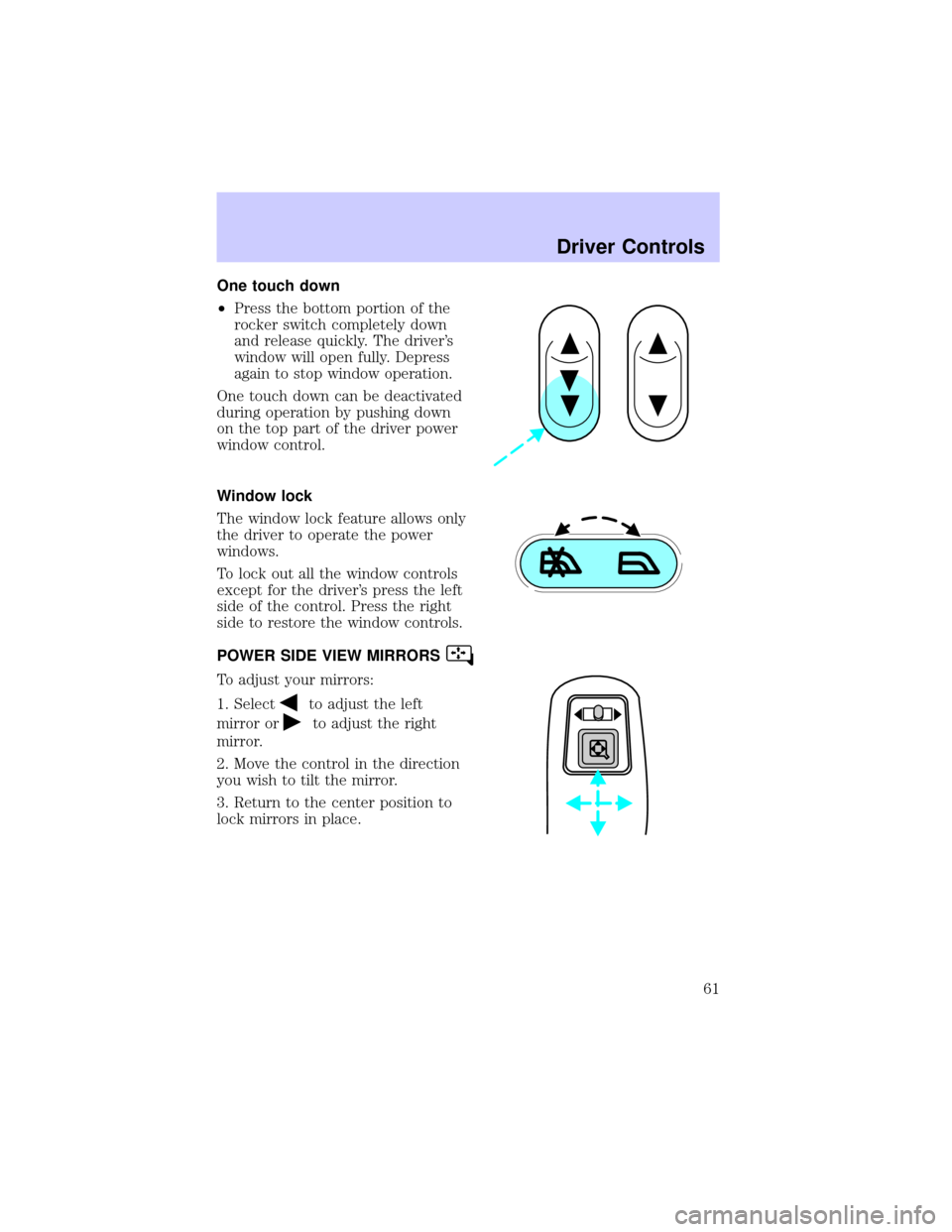
One touch down
²Press the bottom portion of the
rocker switch completely down
and release quickly. The driver's
window will open fully. Depress
again to stop window operation.
One touch down can be deactivated
during operation by pushing down
on the top part of the driver power
window control.
Window lock
The window lock feature allows only
the driver to operate the power
windows.
To lock out all the window controls
except for the driver's press the left
side of the control. Press the right
side to restore the window controls.
POWER SIDE VIEW MIRRORS
To adjust your mirrors:
1. Select
to adjust the left
mirror or
to adjust the right
mirror.
2. Move the control in the direction
you wish to tilt the mirror.
3. Return to the center position to
lock mirrors in place.
Driver Controls
61
Page 62 of 232
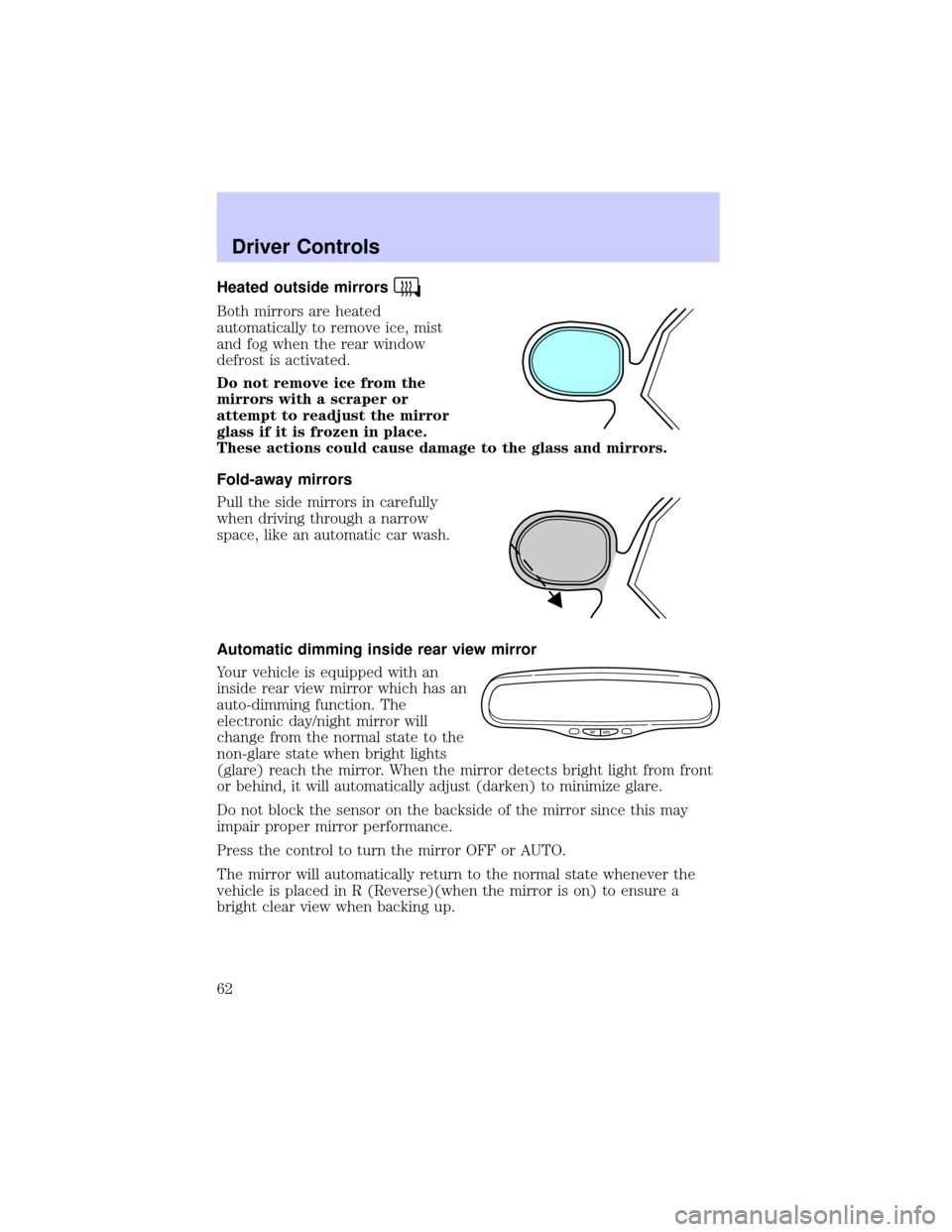
Heated outside mirrors
Both mirrors are heated
automatically to remove ice, mist
and fog when the rear window
defrost is activated.
Do not remove ice from the
mirrors with a scraper or
attempt to readjust the mirror
glass if it is frozen in place.
These actions could cause damage to the glass and mirrors.
Fold-away mirrors
Pull the side mirrors in carefully
when driving through a narrow
space, like an automatic car wash.
Automatic dimming inside rear view mirror
Your vehicle is equipped with an
inside rear view mirror which has an
auto-dimming function. The
electronic day/night mirror will
change from the normal state to the
non-glare state when bright lights
(glare) reach the mirror. When the mirror detects bright light from front
or behind, it will automatically adjust (darken) to minimize glare.
Do not block the sensor on the backside of the mirror since this may
impair proper mirror performance.
Press the control to turn the mirror OFF or AUTO.
The mirror will automatically return to the normal state whenever the
vehicle is placed in R (Reverse)(when the mirror is on) to ensure a
bright clear view when backing up.
OFF AUTO
Driver Controls
62
Page 125 of 232
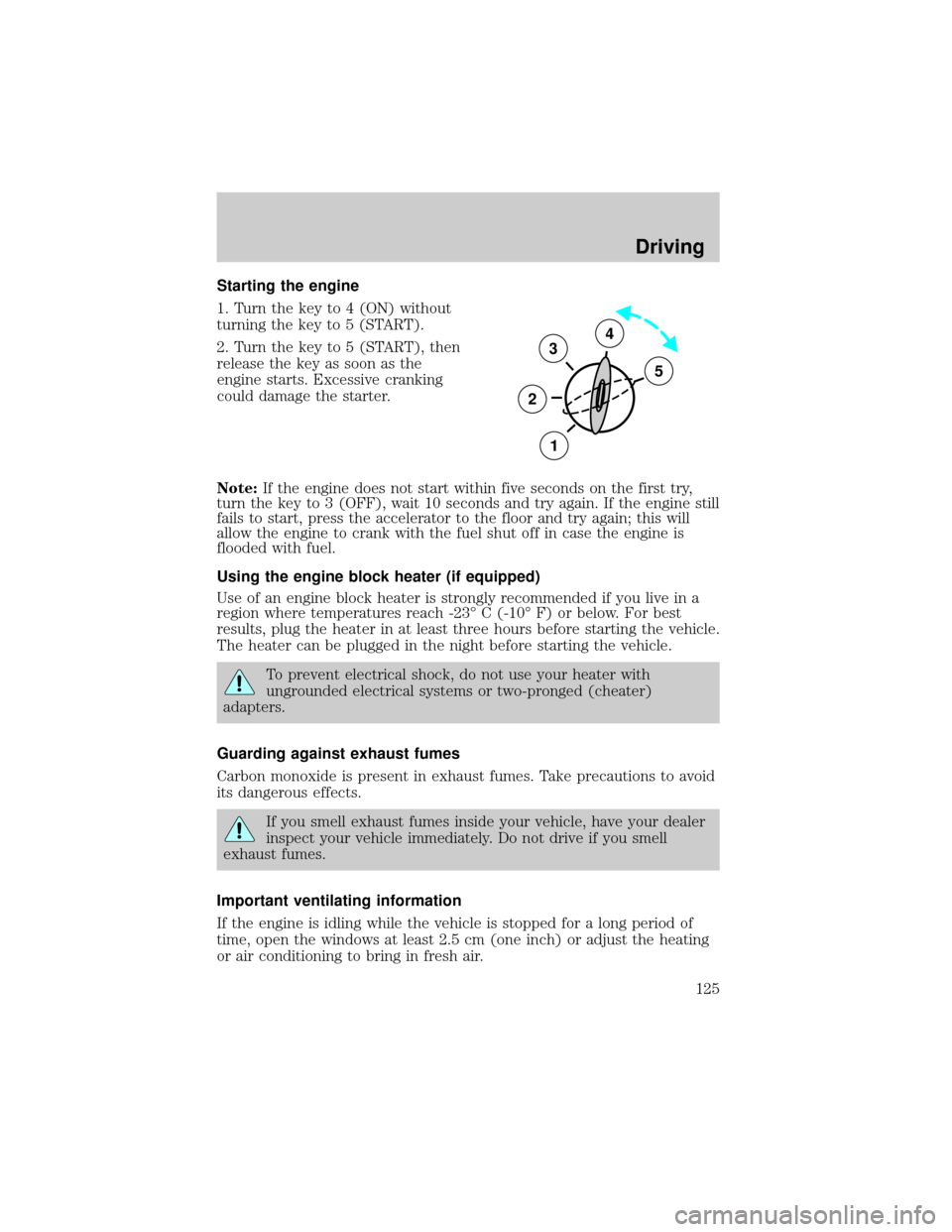
Starting the engine
1. Turn the key to 4 (ON) without
turning the key to 5 (START).
2. Turn the key to 5 (START), then
release the key as soon as the
engine starts. Excessive cranking
could damage the starter.
Note:If the engine does not start within five seconds on the first try,
turn the key to 3 (OFF), wait 10 seconds and try again. If the engine still
fails to start, press the accelerator to the floor and try again; this will
allow the engine to crank with the fuel shut off in case the engine is
flooded with fuel.
Using the engine block heater (if equipped)
Use of an engine block heater is strongly recommended if you live in a
region where temperatures reach -23É C (-10É F) or below. For best
results, plug the heater in at least three hours before starting the vehicle.
The heater can be plugged in the night before starting the vehicle.
To prevent electrical shock, do not use your heater with
ungrounded electrical systems or two-pronged (cheater)
adapters.
Guarding against exhaust fumes
Carbon monoxide is present in exhaust fumes. Take precautions to avoid
its dangerous effects.
If you smell exhaust fumes inside your vehicle, have your dealer
inspect your vehicle immediately. Do not drive if you smell
exhaust fumes.
Important ventilating information
If the engine is idling while the vehicle is stopped for a long period of
time, open the windows at least 2.5 cm (one inch) or adjust the heating
or air conditioning to bring in fresh air.
3
2
1
5
4
Driving
125
Page 146 of 232
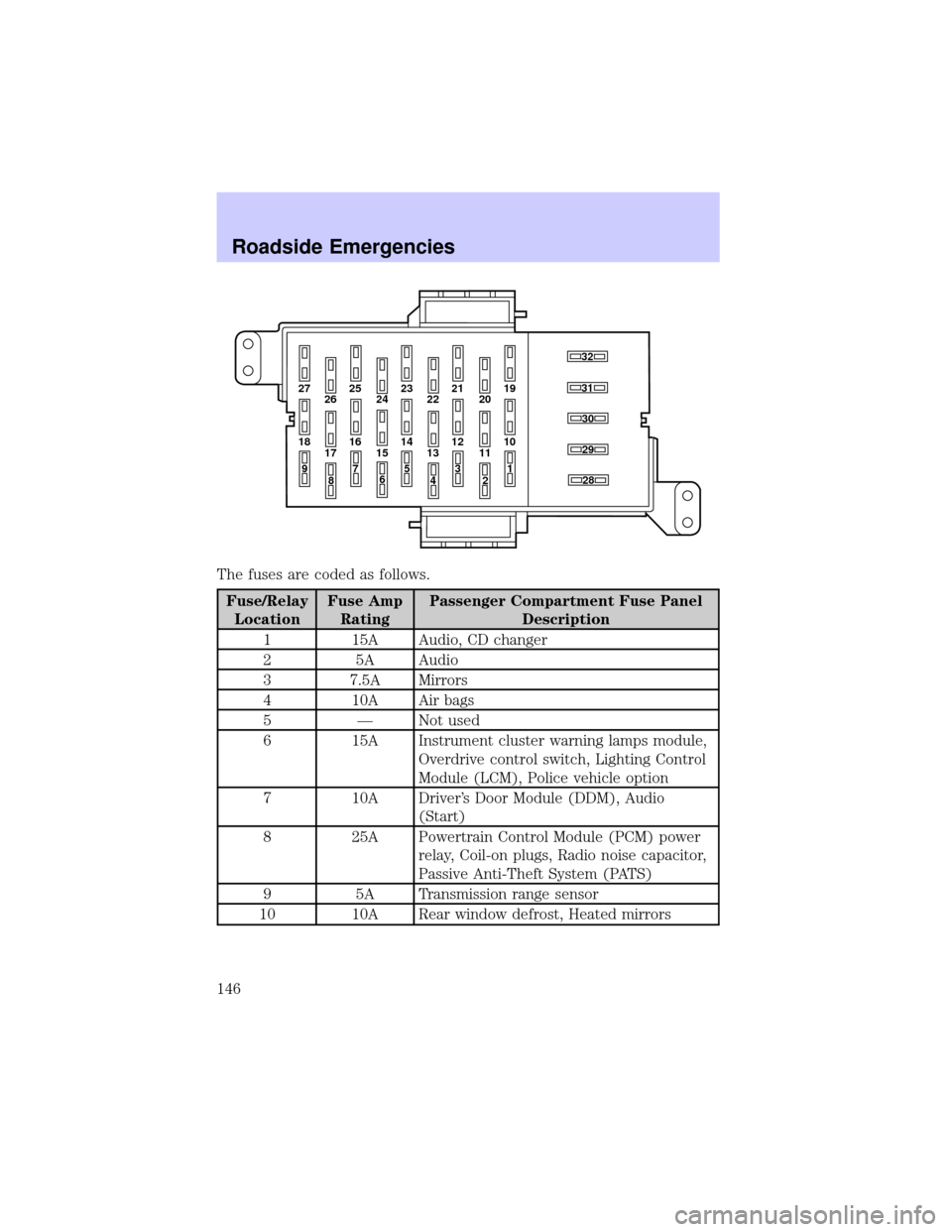
The fuses are coded as follows.
Fuse/Relay
LocationFuse Amp
RatingPassenger Compartment Fuse Panel
Description
1 15A Audio, CD changer
2 5A Audio
3 7.5A Mirrors
4 10A Air bags
5 Ð Not used
6 15A Instrument cluster warning lamps module,
Overdrive control switch, Lighting Control
Module (LCM), Police vehicle option
7 10A Driver's Door Module (DDM), Audio
(Start)
8 25A Powertrain Control Module (PCM) power
relay, Coil-on plugs, Radio noise capacitor,
Passive Anti-Theft System (PATS)
9 5A Transmission range sensor
10 10A Rear window defrost, Heated mirrors
27 25
26 2423 21
2219
20
18 16
17 1514 12
131030
32
31
28
29
11
97
8653
41
2
Roadside Emergencies
146
Page 147 of 232
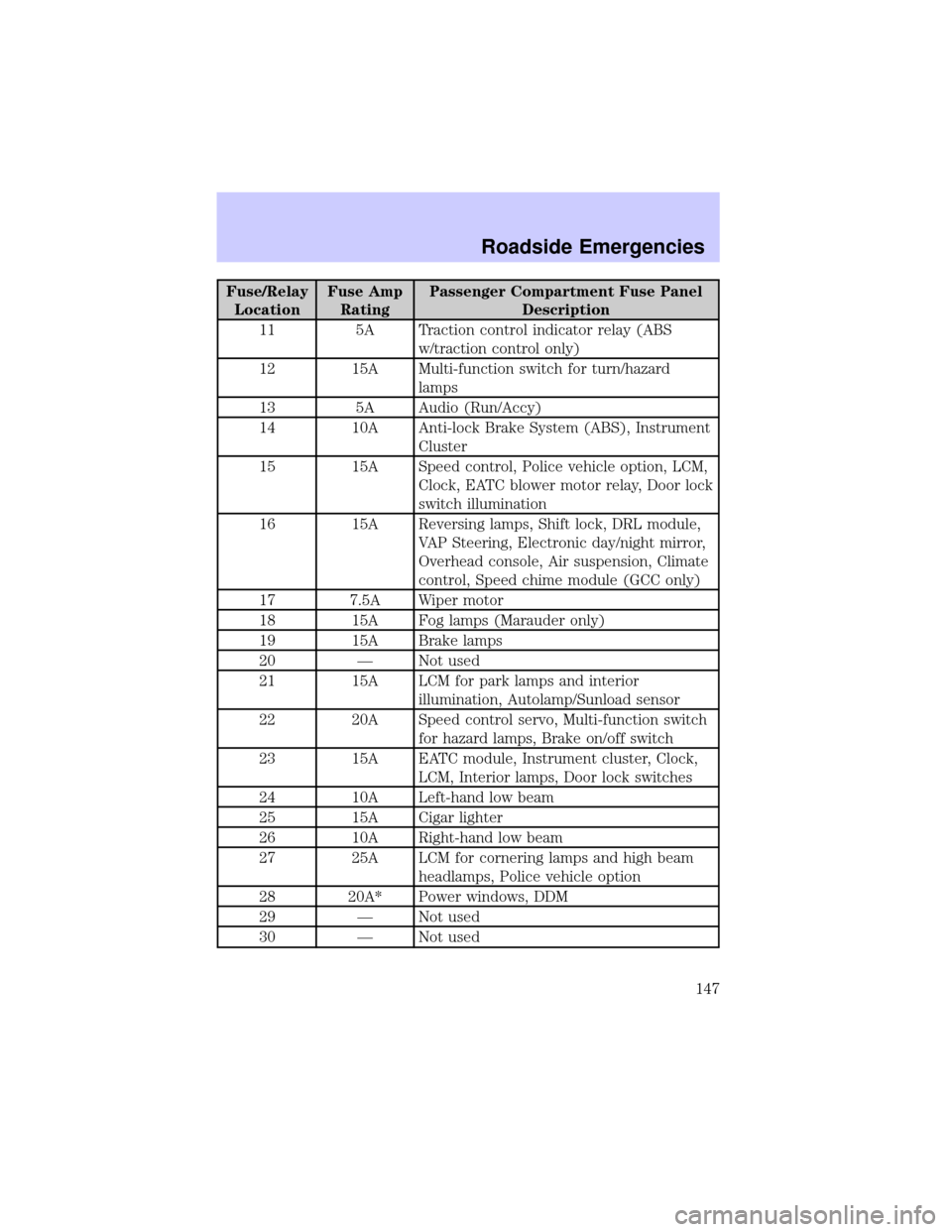
Fuse/Relay
LocationFuse Amp
RatingPassenger Compartment Fuse Panel
Description
11 5A Traction control indicator relay (ABS
w/traction control only)
12 15A Multi-function switch for turn/hazard
lamps
13 5A Audio (Run/Accy)
14 10A Anti-lock Brake System (ABS), Instrument
Cluster
15 15A Speed control, Police vehicle option, LCM,
Clock, EATC blower motor relay, Door lock
switch illumination
16 15A Reversing lamps, Shift lock, DRL module,
VAP Steering, Electronic day/night mirror,
Overhead console, Air suspension, Climate
control, Speed chime module (GCC only)
17 7.5A Wiper motor
18 15A Fog lamps (Marauder only)
19 15A Brake lamps
20 Ð Not used
21 15A LCM for park lamps and interior
illumination, Autolamp/Sunload sensor
22 20A Speed control servo, Multi-function switch
for hazard lamps, Brake on/off switch
23 15A EATC module, Instrument cluster, Clock,
LCM, Interior lamps, Door lock switches
24 10A Left-hand low beam
25 15A Cigar lighter
26 10A Right-hand low beam
27 25A LCM for cornering lamps and high beam
headlamps, Police vehicle option
28 20A* Power windows, DDM
29 Ð Not used
30 Ð Not used
Roadside Emergencies
147
Page 176 of 232

WINDOWS AND WIPER BLADES
The windshield, rear window and wiper blades should be cleaned
regularly. If the wiper does not wipe properly, substances on the
windshield, rear window or the wiper blades may be the cause. These
may include hot wax treatments used by commercial car washes, tree
sap, or other organic contamination. To clean these items, please follow
these tips:
²The windshield or rear window may be cleaned with a non-abrasive
cleaner such as Motorcraft Ultra Clear Spray Glass Cleaner (ZC-23),
available from your dealer.
²Do not use abrasives, as they may cause scratches.
²Do not use fuel, kerosene, or paint thinner to clean any parts.
²Wiper blades can be cleaned with isopropyl (rubbing) alcohol or
windshield washer solution. Be sure to replace wiper blades when they
appear worn or do not function properly.
INSTRUMENT PANEL AND CLUSTER LENS
Clean the instrument panel with a damp cloth, then dry with a dry cloth.
²Avoid cleaners or polish that increase the gloss of the upper portion of
the instrument panel. The dull finish in this area helps protect the
driver from undesirable windshield reflection.
Do not use chemical solvents or strong detergents when cleaning
the steering wheel or instrument panel to avoid contamination of
the air bag system.
²Be certain to wash or wipe your hands clean if you have been in
contact with certain products such as insect repellent and suntan
lotion in order to avoid possible damage to the painted surfaces.
INTERIOR TRIM
²Clean the interior trim areas with a damp cloth, then dry by wiping
with a dry, soft, clean cloth.
²Do not use household or glass cleaners as these may damage the
finish.
Cleaning
176
Page 201 of 232
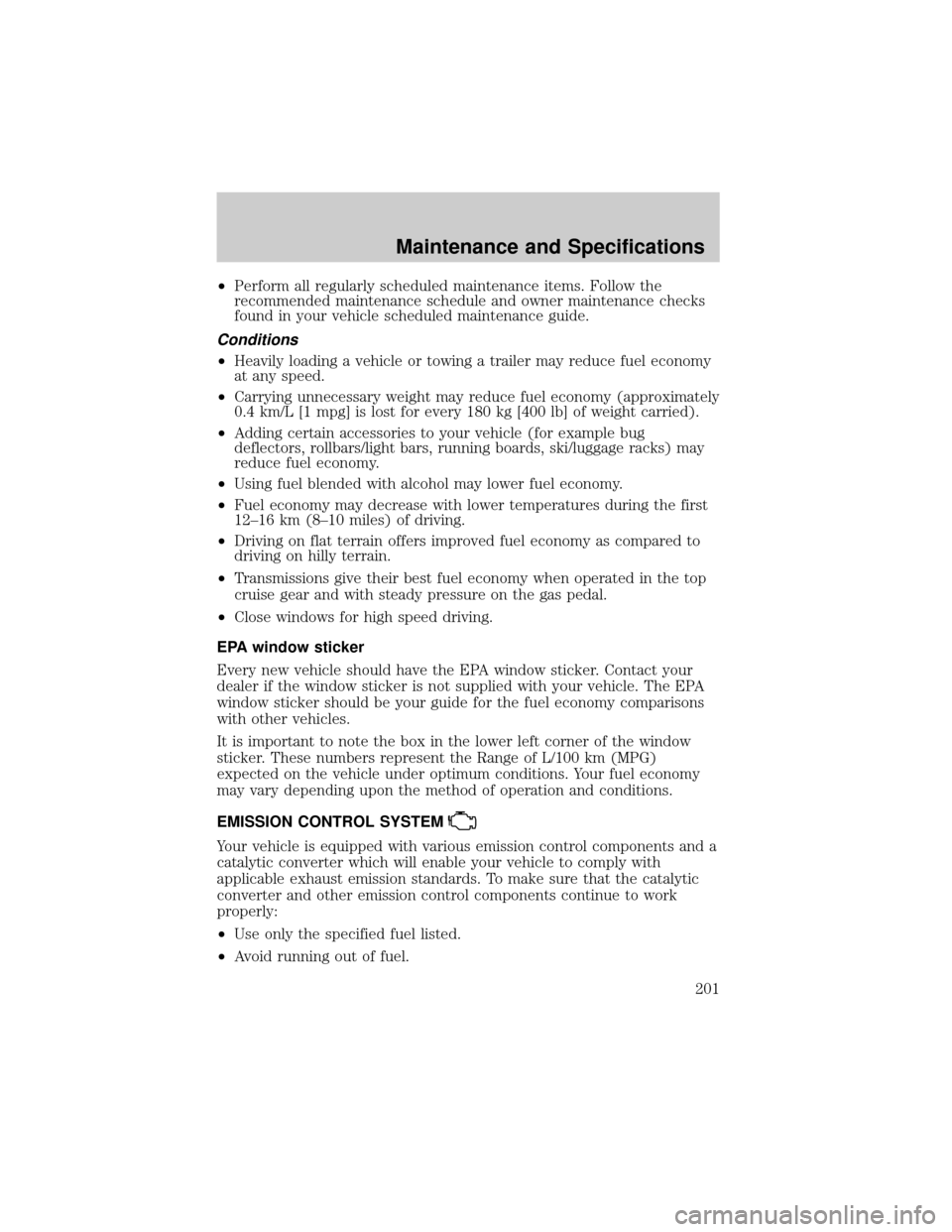
²Perform all regularly scheduled maintenance items. Follow the
recommended maintenance schedule and owner maintenance checks
found in your vehicle scheduled maintenance guide.
Conditions
²Heavily loading a vehicle or towing a trailer may reduce fuel economy
at any speed.
²Carrying unnecessary weight may reduce fuel economy (approximately
0.4 km/L [1 mpg] is lost for every 180 kg [400 lb] of weight carried).
²Adding certain accessories to your vehicle (for example bug
deflectors, rollbars/light bars, running boards, ski/luggage racks) may
reduce fuel economy.
²Using fuel blended with alcohol may lower fuel economy.
²Fuel economy may decrease with lower temperatures during the first
12±16 km (8±10 miles) of driving.
²Driving on flat terrain offers improved fuel economy as compared to
driving on hilly terrain.
²Transmissions give their best fuel economy when operated in the top
cruise gear and with steady pressure on the gas pedal.
²Close windows for high speed driving.
EPA window sticker
Every new vehicle should have the EPA window sticker. Contact your
dealer if the window sticker is not supplied with your vehicle. The EPA
window sticker should be your guide for the fuel economy comparisons
with other vehicles.
It is important to note the box in the lower left corner of the window
sticker. These numbers represent the Range of L/100 km (MPG)
expected on the vehicle under optimum conditions. Your fuel economy
may vary depending upon the method of operation and conditions.
EMISSION CONTROL SYSTEM
Your vehicle is equipped with various emission control components and a
catalytic converter which will enable your vehicle to comply with
applicable exhaust emission standards. To make sure that the catalytic
converter and other emission control components continue to work
properly:
²Use only the specified fuel listed.
²Avoid running out of fuel.
Maintenance and Specifications
201
Page 219 of 232

Travel equipment
Cargo net
Daytime running lights (DRL)
Protection and appearance equipment
All-weather floor mats
ªBº Pillar ecterior trim
Carpeted floor mats
Car cover with Marauder logo
Decklid spoiler
Door edge guards
First aid kit
Flat splash guards
Highway safety kit
Locking gas cap
Molded splash guards
Rear spoiler
Side window deflectors
Styled hood deflector
Universal floor mats
Accessories
219
Page 222 of 232

Child safety seats ......................114
attaching with tether
straps .......................................118
in front seat ............................116
in rear seat ..............................116
Cleaning your vehicle
engine compartment ..............174
instrument panel ....................176
interior .....................................177
interior trim ............................176
plastic parts ............................175
washing ....................................173
waxing .....................................173
wheels ......................................174
wiper blades ............................176
Climate control (see Air
conditioning or Heating) ............33
Clock ............................................24
Compass, electronic
set zone adjustment .................53
Console ........................................74
overhead ..............................51±52
Controls
power seat .................................89
steering column ........................67
Coolant
checking and adding ..............188
coolant temperature light ........13
refill capacities ................193, 211
specifications ..................212, 214
Cruise control
(see Speed control) ....................63
Customer Assistance ................142
Ford accessories for your
vehicle .....................................178
Ford Extended Service
Plan ..........................................165Getting assistance outside
the U.S. and Canada ..............169
Getting roadside assistance ...142
Getting the service you
need .........................................163
Ordering additional owner's
literature .................................170
The Dispute Settlement
Board .......................................166
Utilizing the
Mediation/Arbitration
Program ...................................169
D
Daytime running lamps
(see Lamps) ................................39
Defrost
rear window ..............................37
Dipstick
automatic transmission
fluid ..........................................204
engine oil .................................182
Doors
lubricant specifications ..........212
Driving under special
conditions ..................................135
through water .........................136
E
Emergencies, roadside
jump-starting ..........................156
Emission control system ..........201
Engine ........................................214
check engine/service engine
soon light ..................................10
cleaning ...................................174
coolant .....................................188
Index
222
Page 225 of 232

traction control active ..............13
turn signal indicator .................14
Limited-slip axle .......................135
Load limits .................................136
GAWR ......................................136
GVWR ......................................136
trailer towing ..........................136
Locks
autolock .....................................81
childproof ..................................76
doors ..........................................75
Lubricant specifications ...212, 214
Lumbar support, seats ...............88
M
Mirrors .........................................51
automatic dimming rearview
mirror ........................................62
fold away ...................................62
heated ........................................62
side view mirrors (power) .......61
Moon roof ....................................67
Motorcraft parts ................198, 211
O
Octane rating ............................197
Odometer .....................................17
Oil (see Engine oil) ..................182
Overdrive .............................71, 133
P
Panic alarm feature, remote
entry system ................................79
Parking brake ............................127
Parts (see Motorcraft parts) ....211Passenger Occupant
Classification Sensor ...................92
Pedals (see Power adjustable
foot pedals) .................................63
Power adjustable foot pedals .....63
Power distribution box
(see Fuses) ...............................148
Power door locks ..................75, 81
Power mirrors .............................61
Power point .................................59
Power steering ..................129±130
fluid, checking and adding ....203
fluid, refill capacity ................211
fluid, specifications .................212
Power Windows ...........................60
R
Radio ............................................19
Radio reception ...........................32
Rear window defroster ...............37
Relays ................................144, 151
Remote entry system ...........77, 79
illuminated entry ......................81
locking/unlocking doors .....75, 78
opening the trunk .....................79
panic alarm ...............................79
replacement/additional
transmitters ...............................80
replacing the batteries .............79
Roadside assistance ..................142
S
Safety belts (see Safety
restraints) ............14, 91, 94, 96±98
Safety defects, reporting ..........172
Index
225